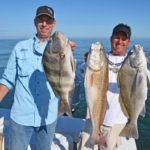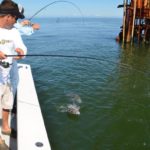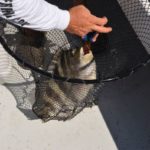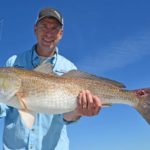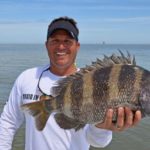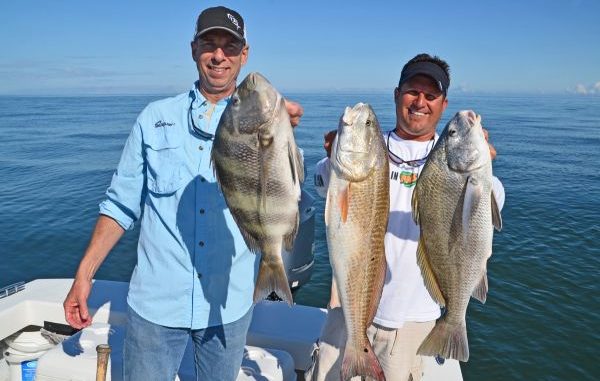
Sure, trout fishing might be inconsistent this month, but head to Breton sound for some great action with redfish, sheepsheads and black drum.
You heard the one about the elite, big-fish speckled trout snob in Delacroix in March?
Well, there was this creek. And there was this paddle. The guy was up the creek: Aw heck, you know the rest.
Some of the best speckled trout fishing in the United States exists out of Delacroix, Hopedale and Shell Beach. Each summer, legitimate 2- to 4-pound speckled trout prowl the open waters of Breton Sound.
When the weather cools in October, the speckled trout fishing heats up in inside marshes, at least in numbers. The big fish have disappeared, but the action is great.
Then comes the dreaded March-to-April transition period.
Our hero could scrounge up a few small trout in the marshes, but he wants a lot of action — he wants fish that pull hard.
So what does this poor man do?
Well, if he’d just listen to Capt. Kerry Audibert, he would head for the sound — Breton Sound.
He would suspend his trout snobbery for a couple of months, but he would have fun.
Ought To Be Fishing Charters’ Audibert (504-259-5304) is based out of Shell Beach-Hopedale and is a speckled trout specialist, especially for big Breton Sound trout.
But the 12-year veteran guide isn’t hard-headed: He takes what Mother Nature gives him and has fun with it.
And what Mother Nature has in Breton Sound in March and April are plenty of willing sheepshead, redfish and black drum — what he calls “heads, reds and drum.”
Joining Audibert on the late-March trip was friend and business associate Drew Davis of Baton Rouge. Davis, a manufacturers’ rep for Mainstream Marketing, travels Louisiana placing fishing tackle from 15 to 20 companies in retail stores.
Besides enjoying a fun day on the water with a friend, Davis would be vetting Mustad hooks and 13 Fishing’s Omen Green spinning rods. The 6-foot, 8-inch, medium-action rods he was testing came to market about a year ago.
Audibert throttled back and idled up to a satellite well. Davis, who doubled as Audibert’s deck hand, hooked up to the rusty, ragged platform with a rig hook on a very short rope meant to keep the boat snugged as close to the platform as possible.
At some of the well guards later in the day, Audibert would use an anchor instead of a rig hook, but with the same intention.
“I want to be as close to the platform as I can so that we can fish straight up and down instead of dragging our hooks over pipes and snags,” the guide said.
Tackle was simple. Audibert tied a jighead directly to his favorite FINS Premium Situational braided line and wormed a whole dead shrimp onto the jighead’s hook.
Braid is best used because it is abrasion resistant and the hard-fighting fish seem to make every attempt to wrap the line around barnacle-covered legs of the platforms, he said.
The guide’s norm for jighead size is 3/8-ounce, but Audibert recommended using the least weight possible that will take the bait to the bottom.
Exact weight, of course, depends upon current strength.
“I will use ¼-ounce or even 1/8-ounce (jigs) when the fish get finicky,” he said. “Sometimes you can see fish near the surface all around a platform’s legs; these fish won’t feed on the bottom.
“So I anchor upcurrent and toss pieces of shrimp to chum them, and mix in small, baited jigheads.”
But on this day the fishing was easy, with next to no casting required. A simple flip of the rod put the bait close to the well, and, once the bait hit the bottom, they simply jigged it occasionally.
Audibert called the fishing, “low-tech.” His tackle salesman partner grinned.
“Yeah, we like it when fishermen are using $5 hard baits and they are fishing where there a lots of teeth,” Davis chuckled.
Davis leaned hard into a big sheepshead that turned its body sideways to gain leverage. Audibert grabbed the landing net and sang out, “That’s a big perch, man.”
Bam! Bam! Bam!
The satellite quickly yielded several sheepshead and a nice black drum. Then the fish got small — big enough to keep, but smaller than Audibert wanted.
The next platform gave up a 28-inch redfish, followed by a 34-incher Audibert turned back because it was “too big.”
He was clearly fishing for food this trip.
After another one identical in size to the first one, he packed it in.
They hadn’t caught a sheepshead, and they had their limits of bull reds.
“Moving a lot is the name of the game until you find the fish,” Audibert said. “Every one of these rigs is different.”
The next platform was bigger, with a bank of flow lines descending into the water on one side. Here, Audibert stabbed a Cajun anchor instead of using the rig hook.
“I like to fish on the side with the flow lines,” he explained. “Plus the tide isn’t doing much. I like to fish on the upcurrent side on weaker water currents.”
This platform produced the first of what would be many doubles of the day. Davis hooked a big black drum, while Audibert nabbed a sheepshead.
Audibert coached Davis to quickly walk to the boat’s stern while fighting a fish to pull it away from the rig’s line-cutting legs.
Audibert released the drum, explaining why.
“That big, they can be wormy,” he said in reference to the intramuscular parasites that often infest big black drum.
Besides a couple more sheepshead, this stop produced a fish that brought a smile to Audibert’s face: a redfish that was under 27 inches long and could be added to the ice chest.
Audibert was an expert at handling sheepshead, a fish notorious for its spiny fins and for being difficullt to unhook.
“I tell people that the best way to handle a sheepshead is not to handle them,” he explained. “Most of the time, while they are in the landing net, they are relaxed enough to keep their mouths open and make hook removal easier.
“Handling them tenses them, and they clench their teeth shut on the hook.”
He dumped the fish straight from the landing net into the ice chest without touching it.
“That also helps to prevent getting stuck by their needle-like fins,” Audibert said. “They are like ice picks.”
During the short hop to the next rig, Audibert observed for Davis’ and my benefit that there’s not a real scheme to picking structures to target.
“There are no better or worse rigs out here for this kind of fishing,” Audibert said. “We’ll just hit random rigs until we hit the pot of gold. Most of the time, you will find a platform that you will end up quitting fishing before the sheepshead quit biting. Other days you have to keep moving.
He said note even murky water will stop the bite.
“This time of year, the Mississippi River is high and the water in Breton Sound may be muddy,” Audibert said. “You can still catch fish because often what you see is fresh river water layered on top. Sometimes, if the layer is not thick, the motor’s wheel wash will turn over green water from beneath.
“But even if not, don’t get discouraged. You are out here; try it.”
He said he doesn’t even look at the river gauges.
“You can’t look at river stages to predict whether to go or not,” Audibert said. “Currents and wind move the water around a lot, and every day is different.”
On this day, the water was trout green with a little dingy tinge.
The next stop drew a blank, and Audibert didn’t give it much time before he hit the road again.
“I want a change of scenery,” he grunted as he hop-scotched past 20 or so platforms to a small well guard near the Central compressor platform.
This stop produced sheepshead after sheepshead — large, medium and small. It was exciting to look into the water and see the convict-colored fish nose into the rig’s legs.
The pair began sight-fishing them.
Often sheepshead followed one of their hooked brethren as it was being wrenched to the surface — “follower-fish,” Audibert dubbed them.
Occasionally, five or six fish ganged up, all trying to take the bait from the hooked fish’s mouth.
“The fighting qualities of sheepshead are superb,” Audibert siad. “I don’t know if it is as good as a redfish; they do more figure 8s than runs. They are whole different fights.
“But I bet if you put a sheepshead up against the same-sized redfish, they would be so-so.”
Their sheepshead were typically hooked within 5 or 10 feet of the rig. Some of the redfish and black drum were caught there, as well, but most were caught farther away while the bait was being bounced away from the structure.
In the midst of the melee, Audibert called for lines to be pulled in.
“Let’s try new turf,” he blurted out.
Apparently these sheepshead weren’t quite big enough for him.
He ran the boat five minutes southwest.
“This rig usually holds reds,” he observed.
The water wasn’t as pretty here, with a layer of milky river water on top. The spot gave up two big reds, both of which were released.
A short hop to the next rig produced the same result: all redfish, all too big.
Audibert turned the boat northwest toward his home port before stopping at a single satellite. The water was still milky; there wouldn’t be any sightfishing at all.
But they didn’t need to see the fish: It was one sheepshead after another — all huge ones.
These were spawning fish. The males were all running sperm from their vent.
“This is the way it’s supposed to be,” Audibert chuckled. “When I have four fishermen on the boat, I have two on each side. When the foremost fisherman on either side hooks a fish, he walks it to the back and the other guy rotates to the front.
“I just stay in back and unhook fish.”
In spite of the fish’s size, their bites were so subtle they couldn’t be felt. But alternately picking the rod tip up and dropping it gave their presence on the line away.
The huge ice chest was rapidly filling up.
“Another gorilla,” Audibert said as Davis’ reel screamed.
Finally, there was no more room in the box. Audibert stood there with his latest fish, looking for a spot to wedge it in.
’Twasn’t any.
He shrugged his shoulders, smiled and dumped it back overboard.
It was 12:30 p.m.
